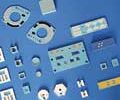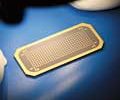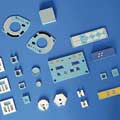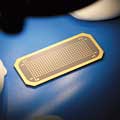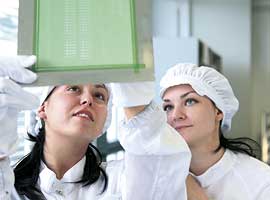“In Landshut, we have been developing and manufacturing hermetic seals for sensitive electronic and opto-electronic components since 1941,” says Andreas Becker, Managing Director of SCHOTT Electronic Packaging GmbH in Landshut and head of the Opto-electronics product division at SCHOTT Electronic Packaging. “In addition to glass, multilayer ceramics are being used more frequently. We are now the only vendor in Europe that is able to supply all types of housing technologies directly from a single source.”
Glass-to-metal sealed housings, ceramic-to-metal sealed housings and all-ceramic packages offer permanent hermetic protection. They are also insensitive to vibrations, corrosive substances and temperature fluctuations. Of all of these technologies, glass-to-metal sealed packaging is the most popular solution. These versatile materials offer long-term hermetic protection in a wide range of applications, such as airbag igniters and large-scale feedthroughs in power plants. Multilayer ceramics are the right choice in situations where very small and lightweight components are needed. The conductors are printed onto thin sheets of ceramic that are then stacked and sintered. This allows for a high number of conductors to be connected together in a complex manner inside the smallest of spaces. Multilayer ceramics are indispensable when it comes to miniaturizing electronic and opto-electronic components, as well as high-frequency applications.
High data rates need to be processed in telecommunications, in particular, but also in X-ray and radar applications. High temperature cofired ceramics (HTCC) are used when the signal path is rather short and superior mechanical stability and heat dissipation is important. Low temperature cofired ceramics (LTCC) with metallization that consist of precious metals are used for extended path lengths.
SCHOTT has more than 10 years of experience in the area of HTCC. Manufacturing of these products has just been transferred from Japan to Landshut in order to better serve the company’s customers in Europe and the United States. In addition, SCHOTT has also expanded its LTCC range with a long-term cooperation agreement with VIA electronic GmbH, a company based in Hermsdorf, near Jena.
“We are proud of our reputation as an extremely agile and knowledgeable development partner who has a lot of expertise in the area of microsystems technology,” says Franz Bechtold, Managing Director of VIA electronic. “Our relationship with SCHOTT now ensures us access to a global sales network and industrial manufacturing capacities. This will enable us to accompany our customers much more effectively on everything from prototypes to mass production,” he adds.
Together with VIA electronic, SCHOTT Electronic Packaging supports its customers in designing the right packages for their applications. Simulations allow for predictions on material behavior during high-frequency conditions, including the examination of thermal performance and mechanical stability. The capabilities cover the design of electronic and opto-electronic components through to process optimization for prototype and mass production.

